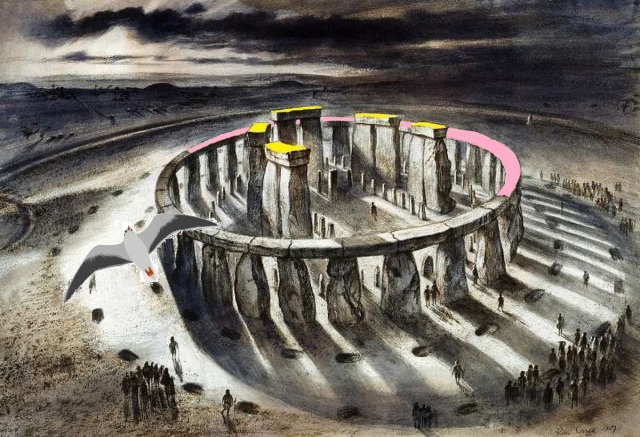Summary
Forget all the tosh about Stonehenge being a temple. Long
before there were any stones, there was a laboriously excavated chalk circle,
comprising a ditch and adjacent heap of spoil, i.e. raised bank, the two being
collectively termed a “henge”.
Henges must have had a purpose, even if archaeology seems largely uninterested in why there were - and still are - so many henges dotted across Britain.
 |
| BBC feature from 1999 on Seahenge (despite there having been no henge, merely a timber circle and that central inverted tree trunk -almost certainly an AFS site.). |
In fact, archaeology even seems uninterested in the
timber poles that appeared within the chalk
circle at Stonhenge BEFORE any standing stones, despite timber poles atSeahenge (still surviving to this day) having a fairly obvious purpose alluded
to briefly in the 1999 BBC report. (Shhh. Don’t mention the E word, or animals
that have wings – and sharp beaks).
This blog post tells you what archaeology is not terribly
keen for you to know about the proto-Stonehenge, indeed the Non-Stone-henge, the
simpler Chalkhenge, preferring to hurry you along to the megaliths, with a
narrative in which the word “temple” is
invoked, even pre-cathedral, with much about pre-Druids, early pagan ritual etc
etc. This blog post is about the initial
role of Chalkhenge, the same as that inferred for numerous other sites with a
few human bones, sometimes “cremated bones” as at Stonehenge. But it was almost
certainly not the energy-wasteful whole-body cremation requiring a huge pyre of bone-dry
timber (tarpaulins being unavailable). It was end-stage cremation of the
deceased following what might be termed “avian-facilitated skeletonization”
(AFS). Yes, we’re talking about “sky burial”, or, as archaeology generally refers
to briefly in passing (if at all) as excarnation, or defleshing. Chalkhenge
(proto-Stonehenge) was cleverly designed to attract the right kind of scavenging
birds, one that could quickly reduce a
body to a near-skeletonized state, one that could then be quickly and efficiently
end-cremated to noffensive minerals (cremated bone being little more than
calcium phosphate, the stuff that gardeners use as fertilizer).
Here’s a brief account of an experiment I have just done,
this very morning, to model Chalkhenge using white flour. ( I am developing a
soft spot for flour, it having provided a solution to the Turin Shroud, starting about a
year ago).
Here's an artist's impression of "Chalkhenge" which I've photographed from the English Heritage guide to Stonehenge (Page 33, "The First Stonehenge").
Here's the same image swung round to orient the entrance "north-east", with the ground-skimming incoming first light of day from the horizon shown by the yellow arrow. See the publisher's guide to compass directions (lower right, yellow rectange). The yellow is my addition.
It's the image directly above that I set out to model, using a torch to simulate the rising sun.
 |
| Place inverted saucepan on board. Sprinkle flour around the circumference. Remove saucepan. |
 |
| Here's a close-up of the above, with a little photoenhancement. |
One need hardly say that anything placed in the central zone would be highly conspicuous, not viewed from ground level outside the henge, but from above, e.g. by a hungry bird!
And what might that something be? Do I need to spell it out? Yes, the body of a newly-deceased individual, intended for "pre-cremation". Attract the scavenger birds at the crack of dawn, so as to make maximum use of daylight (assuming that birds are probably not nocturnal feeders for fear of ground-based predators).
In the model thus far, there is nowhere for the birds to roost or feed on stripped flesh except on the crest of the henge. The next step in the evolution of Stonehenge was the installation of timber posts (see the EH guide for the complex multi-stage history of timber insertion which may or may not have involved the ring of so-called Aubrey holes close to the bank).
I'll stop here for now. Google will probably ignore this posting, the way it has my earlier ones, preferring to grow Google Search as a glorified trade directory, dedicated to the promotion of e-commerce and Google's bottom line.
Regard this posting then as mainly archival (initial instalment). What you see so far is the nucleus. Immediate afterthoughts will be added under Comments, if only to prime the latter and encourage readers to place their own comment here rather than elsewhere.
I may return in a few days to add substantial new content here. but won't do that right now, knowing or at least suspecting it will scare off the finnicky search engine crawlers that prefer to have everything set in concrete from the word go on the assumption we're all peddling a commercial product and need to present a polished fait accompli at first attempt.
Sorry, I'm a retired scientist. I don't do the fait accompli. Everything is a work in progress. It's the nature of research - venturing into uncharted territory. What a shame, nay scandal, that Google and the other search engines fail to make allowance for that fact, treating us all as if scam artists, despite track records going back for hundreds of postings over a decade or longer (longer in my case). Why is so much of the internet in the hands of a certain brand of creepy, controlling Californian?
Nope. This blogger is a humble seeker after truth, and if the truth be told, neither Stonehenge, nor a myriad of other henges were intended as "temples" or "pre-cathedrals" as so many in 'mainstream' archaeology would have us believe (or worse still assume). Stonehenge was certainly designed as a pre-something in my humble opinion - ingeniously so if my model above is correct. as I believe it to be. The proto-Stonehenge was designed as a pre-crematorium, letting wildlife on the wing do most of the defleshing of the dead, saving crematiion as the final clean-up stage. Relatives could then be presented with a compact package of clean hygienic remains either to inter on site if permitted to do so (there being no shortage of cremated bones at Stonehenge) or to take away for storage and veneration elsewhere, confident in their assumption that AFS had freed the spirit from the corpse. It's not so very different from modern-day cremation when one thinks about it, except for the way no one dwells on the details of what happens inside the gas-fired incinerator whereas "excarnation" , on the rare occasions it reaches the MSM, still attracts adjectives like "grisly", "gruesome", "bizarre" etc, That's despite the likelihood of the sharp end of the procedure having been overseen by a specialist cadre of hardened professionals , protected from public gaze by the henge banks at least, and later by a forest of timber posts, and later still, those final standing stones...,
Addendum: March 16, 2018
I've decided to add this latest image of mine as an update to ALL my Stonehenge postings (some 24 in all, here and on my specialist Stonehenge site). Why not – since it’s my considered answer to the ‘mystery’ of the monument’s peculiar architecture, the conclusion to some 6 years of deliberation?

I say Stonehenge was designed as a giant bird perch, a ceremonial monument dedicated to ‘sky burial’, i.e. soul release from mortal remains to the heavens via AFS (avian-facilitated skeletonization, considered the height of fashion (and practicality) in Neolithic-era 2500BC! The stripped remains were then cremated, so an apt description of Stonehenge might, as previously suggested, be PRE-CREMATORIUM.
The sills of the inner 5 trilithons have been colour-coded yellow, while pink has been used to partially colour-code the outer stone circle (believed to have once been continuous as shown in this artist's impression from an English Heritage site). In addition to the colour-coding, I've also added a token gull (sorry it's upside down!).
























2 comments:
I see that the wiki entry for henge makes no mention whatsoever of "sky burial" etc:
https://en.wikipedia.org/wiki/Henge
In fact it offers no explanation for this feature, apart from vague references to "ritual landscape".
Note the ominous reference however to something happening within the confines of the henge that was, er, problematical, and not something that could be discussed freely. Hmmm.
Have been watching a YouTube video that follows Prof Mike Parker-Pearson and his timeas they excavate in and around Stonehenge, with particualr emphasis on "cremated bones". A comment sent to my own site (!) an hour ago disappeared without trace when I hit Send. It also mentioned the failure, yet again, of the "Latest Comment" widget, that fails to display, while advertizing itself! The third party provider is no longer accepting comments (and complaints) on his his site.
Here's a link to the video:
https://www.youtube.com/watch?v=Xl6PaGi270Q
Let's see if this posts (being careful this time to copy first!). If it does, I'll return to copy/paste the two comments I placed earlier this morning. The first addresses the ambiguity in use of the term "cremated bones", and the second the reasons for Stonehenge being aligned with the solstices, as demonstrated in this posting.(In fact, once can only properly talk of results, not reasons!).
Post a Comment